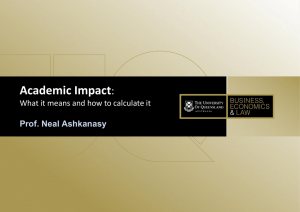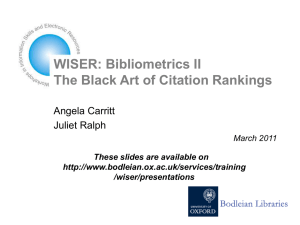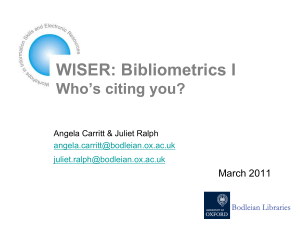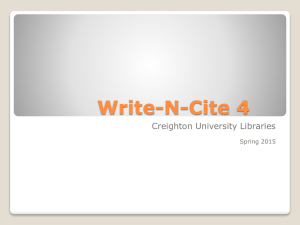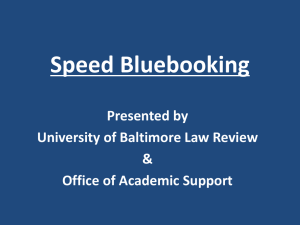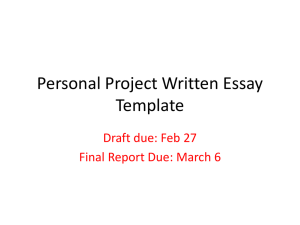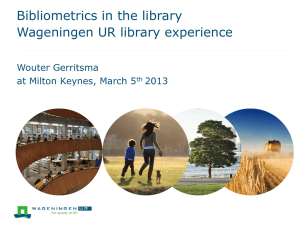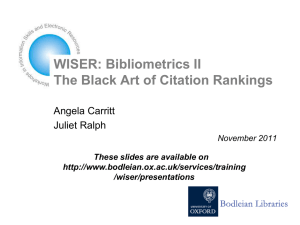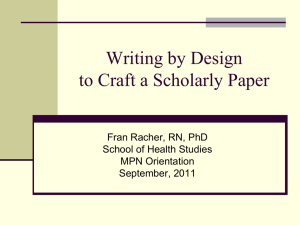Increasing impact of journal articles presentation
advertisement
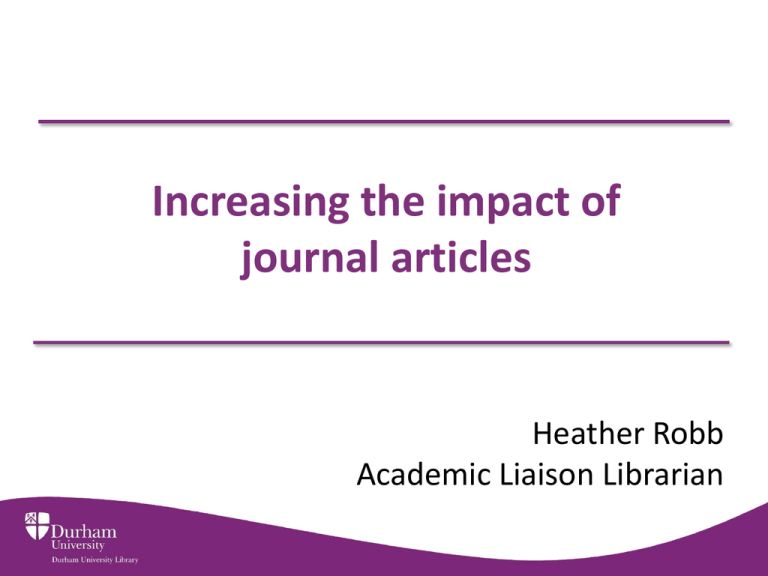
Increasing the impact of journal articles Heather Robb Academic Liaison Librarian Session outline • Importance of getting your research read • Individual citations • Where to publish – High ranking: journal citation reports – Improving your citation count: Open Access and repositories • Optimising “citability” Quick survey… • • • • • WoK/WoS JCR SciVerse Scopus PoP software JULIET • • • • • JIF Eigenfactor SCImagoJR SNIP h – index Getting your research read • Making research visible • Why? – Establishing research profile – Research Evaluation Framework • How? – Reputable publishing routes – New routes – Networks (2008) Taylor and Francis LibSite Newsletter, issue 9. p. 2 (2008) Taylor and Francis LibSite Newsletter, issue 9. p. 3 Things to consider • • • • Impact does not always = excellence Citation cultures vary across disciplines Publication cultures vary too Research careers have different stages Citations to individual papers • Links between papers that have something in common • Tool to make connections • Building on or challenging research • Help make a judgement about impact an article has made • Sum of citations useful indication of impact of an author Web of Science • 1955 E Garfield first published the idea of measuring “impact” of journals using citations • Science Citation Index (now part of Thomson Reuters WoS) developed to highlight “formal, explicit linkages between papers that have particular points in common” • Shift in use of this data to measure impact of research - “a mortal sin” (Ton van Raan, 2010) Science subjects Social-science subjects (2008) Taylor and Francis LibSite Newsletter, issue 9. p. 5 SciVerse Scopus • Launched in 2004 by Elsevier • Serious competition to Web of Science • Main emphasis on science initially but broader now • Currently indexes 17000 journals plus conference proceedings • No access via Durham as we have WoK Google Scholar • Data for broader range of documents e.g. books, reports • Broader range of documents contribute to higher number of citations • More useful for recent documents • Useful for subjects not covered by WoS • More comprehensive in some areas • Trace developments/versions of same paper Publishers • • • • List of references Can pull citation data from other providers Some link to references and cited works Alerts depend on citation in another journal published by same publisher Things you can do • • • • • • Count citations Link to other related articles Set up citation alerts Search for cited references See citation reports for journals and authors Citation mapping • Web of Science DEMO Measuring & monitoring citations • Counting citations – WoS, Scopus, JStor, SD, publishers and GS • Linked references – WoS, Scopus, JStor, publishers • Citation alerts –WoS, Scopus, publishers & GS • Cited Reference Search – WoS, Scopus • Citation Report – WoS, Scopus • Map citations to find related material – WoS Citation metrics • h-index (Hirsch, 2005) – An author’s number of articles (h) that have received at least h citations – a researcher with an h-index of 10 has published 10 articles that have each been cited at least 10 times • g-index (Egghe, 2006) – The highest number (g) of papers that together received g2 or more citations – a researcher with a g-index of, say, 10 has published 10 papers that together have been cited at least 100 times Activity • Use Web of Science to try a citation search for an article and look at the citation report • Look for the same article in Google Scholar. How do the number of citations vary using Google Scholar? Publish or Perish software • • • • • • Anne-Wil Harzing (2006) now up to ver 3.1 Aimed at individual researchers Analyze their own performance Uses a range of metrics Free to download PoP Book: your guide to effective and responsible citation analysis. 2010 • http://www.harzing.com/pop.htm Google Scholar Citations • Aimed at individual researchers • To keep track of citations to their papers • Free to register your account and set up your profile Journal impact – JCR • Uses citations to measure impact of a journal, mainly for science and social science subjects • Impact factor = average number of citations in a year given to those papers in a journal that were published during the two preceding years • A journal that is cited once, on average, for each article published has an JIF of 1. Impact factor Journal X’s 2009 impact factor Citations in 2009 (in journals indexed in Web of Knowledge) to all articles published by Journal X in 2007 & 2008 = Number of articles (deemed to be citable by Web of Knowledge) that were published in Journal X in 2007 & 2008 Web of Knowledge Activity • Look up a journal or subject area on Journal Citation Reports via Web of Knowledge Journal impact – Eigenfactor • • • • Uses WoS data Get scores based on broader algorithms Uses variety of document types Visualisations – interactive browser useful for publishing in another disciplines Eigenfactor Journal impact – SCImagoJR • Uses data from SCOPUS • Average number of weighted citations received in given SJR year by documents published in preceding three years. • Ranking weights article cited in high ranking journal rather than treating all citations the same • SNIP – source normalized impact per paper ScimagoJR Activity • Use Eigenfactor or SCImago to look at different types of ranking available for a journal and compare with it’s impact factor in Web of Knowledge Open Access Publishing • Open Access movement – making publicly funded (and other) research freely available – Research Councils and other funders’ mandates, see JULIET • Journals – Open Access Journal = free for all OR charge for outgoing articles – DOAJ, Journal Info Open Access Publishing • Repositories – General listing: OpenDOAR – Subject: arXiv – Institutional: Durham Research Online (DRO) – See RoMEO, find out if a publisher allows deposit • Harvesters – OAIster – DRIVER – Google Scholar – not just OA material Activity • Use JULIET to find your funder or one in your subject area • Look at subject or institutional repository or harvester for relevant research articles Optimizing your “citability” • • • • • Construct a clear, descriptive title Reiterate key phrases in the abstract Improve ranking in databases and search engines Human decision-making Easier to find = more likely to be read = more likely to be cited • Downloads beginning to count as impact (eg PLoS) Wiley Blackwell guidelines http://authorservices.wiley.com/bauthor/seo.asp Australia's Forgotten Victims Ever since the British colonists in Australia became aware of the disappearance of the indigenous peoples in the 1830s, they have contrived to excuse themselves by pointing to the effects of disease and displacement. Many colonists called for the extermination of Aborigines when they impeded settlement by offering resistance, yet there was no widespread public acknowledgement of this as a policy until the later 1960s, when a critical school of historians began serious investigations of frontier violence. Their efforts received official endorsement in the 1990s, but profound cultural barriers prevent the development of a general awareness of this. Conservative and right-wing figures continue to play down the gravity of what transpired. These two aspects of Australian public memory are central to the political humanisation of the country. Genocide and Holocaust Consciousness in Australia Ever since the British colonists in Australia became aware of the disappearance of the indigenous peoples in the 1830s, they have contrived to excuse themselves by pointing to the effects of disease and displacement. Yet although genocide was not a term used in the nineteenth century, extermination was, and many colonists called for the extermination of Aborigines when they impeded settlement by offering resistance. Consciousness of genocide was suppressed during the twentieth century until the later 1960s, when a critical school of historians began serious investigations of frontier violence. Their efforts received official endorsement in the 1990s, but profound cultural barriers prevent the development of a general genocide consciousness. One of these is Holocaust consciousness, which is used by conservative and right-wing figures to play down the gravity of what transpired in Australia. These two aspects of Australian public memory are central to the political humanisation of the country. Conclusions • Different resources give different results for author and publication impact • Need to understand what is being measured • Citations can be an indicator of article or author impact • Journal rankings give an idea of which journals are cited most frequently • Open Access increases reach of research • Need to consider what will attract readers References Hirsch, J.E. (2005) An index to quantify an individual’s scientific research output. PNAS. 102(46): 16569-16572 (original h-index paper) Smeyers, P & Burbules, N.C. (2011) How to improve your impact factor: questioning the quantification of academic quality. Journal of Philosophy of Education. 45(1): 1-17 Van Noorden, R. (2010) A profusion of measures. Nature. 465: 864-866 (has a handy “field guide to metrics”) . Part of a Nature special issue at www.nature.com/metrics www.journalmetrics.com (2010) The evolution of journal assessment. (compares SCIMagoJR, AI, SNIP and JIF metrics in table at the end) Evaluation Please fill in the evaluation form – your comments are greatly appreciated! For more information contact Heather Robb – heather.robb@dur.ac.uk – 0191 3340276 or 0191 3341585

